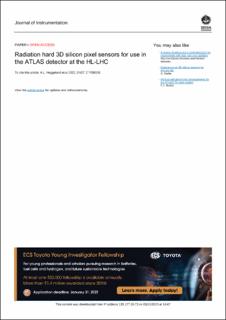Radiation hard 3D silicon pixel sensors for use in the ATLAS detector at the HL-LHC
Heggelund, Andreas; Huiberts, Simon Kristian; Dorholt, Ole; Read, Alexander Lincoln; Røhne, Ole Myren; Sandaker, Heidi; Lauritzen, Magne Eik; Stugu, Bjarne Sandvik; Kok, Angela; Koybasi, Ozhan; Povoli, Marco; Bomben, M.; Lange, J.; Rummler, André
Journal article, Peer reviewed
Published version

Åpne
Permanent lenke
https://hdl.handle.net/11250/3042082Utgivelsesdato
2022Metadata
Vis full innførselSamlinger
Originalversjon
Journal of Instrumentation (JINST). 2022, 17 (8), P08003. 10.1088/1748-0221/17/08/P08003Sammendrag
The High Luminosity LHC (HL-LHC) upgrade requires the planned Inner Tracker (ITk) of the ATLAS detector to tolerate extremely high radiation doses. Specifically, the innermost parts of the pixel system will have to withstand radiation fluences above 1 × 1016 neqcm-2. Novel 3D silicon pixel sensors offer a superior radiation tolerance compared to conventional planar pixel sensors, and are thus excellent candidates for the innermost parts of the ITk. This paper presents studies of 3D pixel sensors with pixel size 50 × 50 μm2 mounted on the RD53A prototype readout chip. Following a description of the design and fabrication steps, Test Beam results are presented for unirradiated as well as heavily irradiated sensors. For particles passing at perpendicular incidence, it is shown that average efficiencies above 96% are reached for sensors exposed to fluences of 1 × 1016 neqcm-2 when biased to 80 V.
